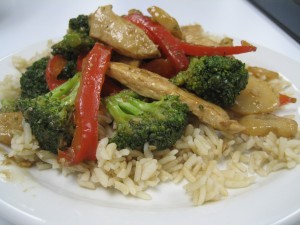The first Tuesday of every month we will be featuring a grain. The posts will include background on the grain, nutritional information, instructions on how to store and cook it, and, of course, one or two healthy recipes for using the grain. Our goal is to help you add variety to your meals in 2012!
Last year, we featured Spice of the Month posts to help add flavor to your dishes without added calories. Those posts can all be found by clicking on the Recipes tab at the top of the page then scrolling down to Spices Posts.
Now that we’ve helped build up your spice rack, we’ve decided this year we’re going to help you build your grain pantry. As delicious as pasta and sandwich bread are, it’s easy to get bored. Different grains supply different tastes, different nutrients, and, most importantly, different textures.

Brown Rice: Far from strange, brown rice has become a staple in most households. While white rice once dominated the rice world, brown rice is now just as common, even being offered in sushi and Chinese restaurants as a healthy option.
Nutritional Profile:
Because only the hull (outermost layer) of the rice kernel is removed during processing, brown rice retains the most nutrients out of the rice varieties. It is an excellent source of manganese (important for your nervous system as well as many other physiological processes), fiber, and selenium. It also contains numerous other vitamins and minerals not found in other rice varieties. Brown rice is considered a whole grain.
Buying and Storing:
Both long grain brown rice and short grain brown rice can be found in the grocery store. There is no nutritional difference between long grain and short grain, it’s really up to you which texture you prefer. Brown basmati rice can also be found in stores, making it a great option for Indian-inspired dishes. The most-wallet friendly way to buy brown rice is in bulk — just be sure to store it properly!
Uncooked brown rice should be stored in an air-tight container in your pantry or cupboards. Once cooked, rice can be saved in the refrigerator. However, if you’ve ever saved rice you’ll know that it can get a bit hard. To heat up leftovers, simply add a little bit of water to the rice in a pot on the stove until the rice has absorbed the moisture.
Preparing:
As a general rule, prepare brown rice with a 1:2 ratio of rice to liquid. For four servings, place 1 cup uncooked brown rice in a pot with 2 cups water. Bring to a boil. Reduce heat to medium-low, cover with a tight-fitting lid, and let simmer until the water is absorbed (about 40min). Once water is absorbed, remove pot from heat and let sit with the cover still on for 10 minutes then fluff with a fork. Don’t have an hour? You can also buy 20 minute and 10 minute varieties as well.
Tried-and-True Sargent Choice Recipes:
- Sargent Choice Brown Rice Vegetarian Sushi
- Healthy Broccoli Chicken Stir Fry
- Sargent Choice Fried Rice with Scallions, Edamame, and Tofu
Have a favorite recipe that uses brown rice? We’d love to hear it! Leave us a comment below.

One Comment
distillery equipment posted on July 27, 2022 at 3:13 am
how are you